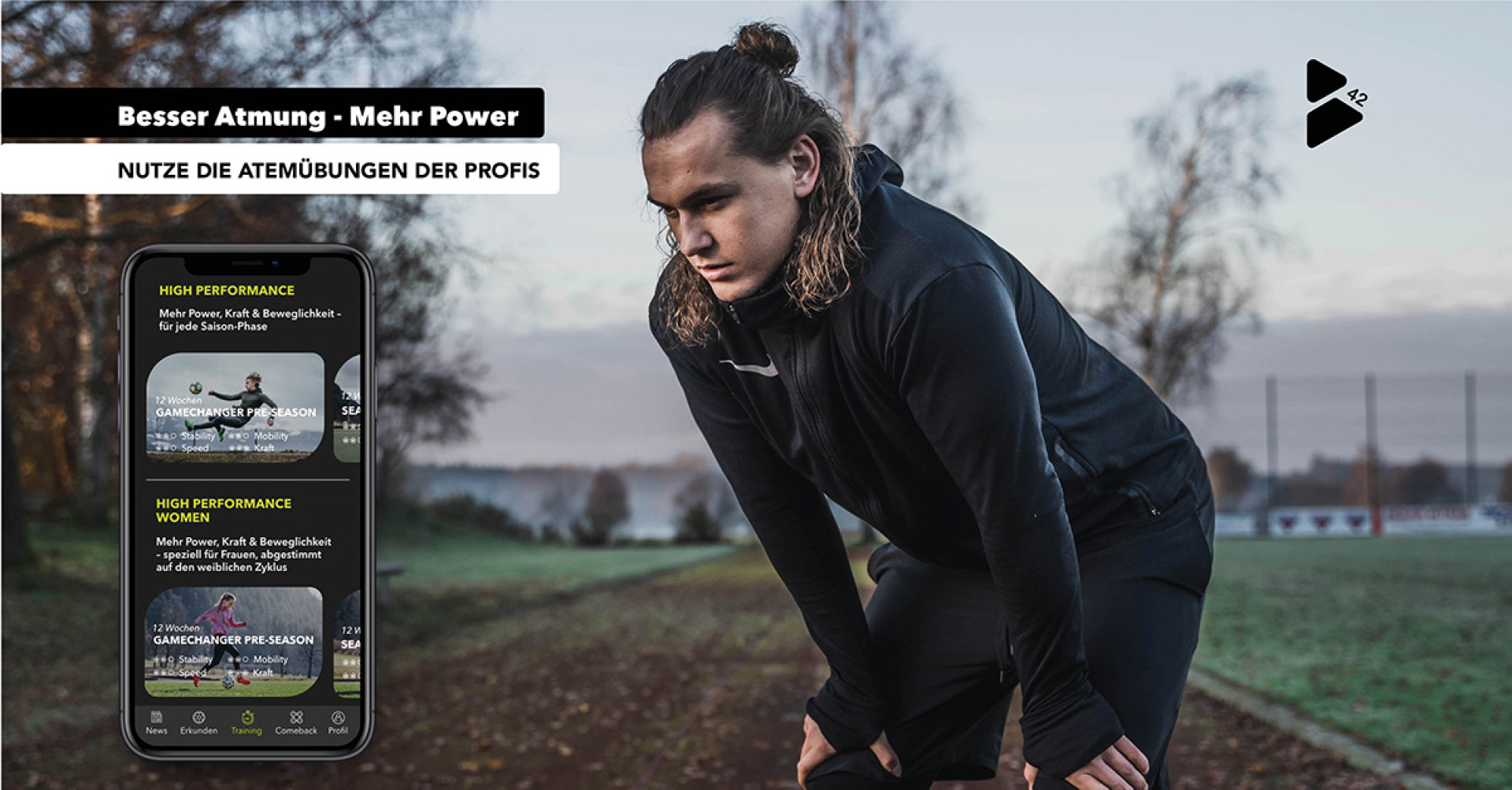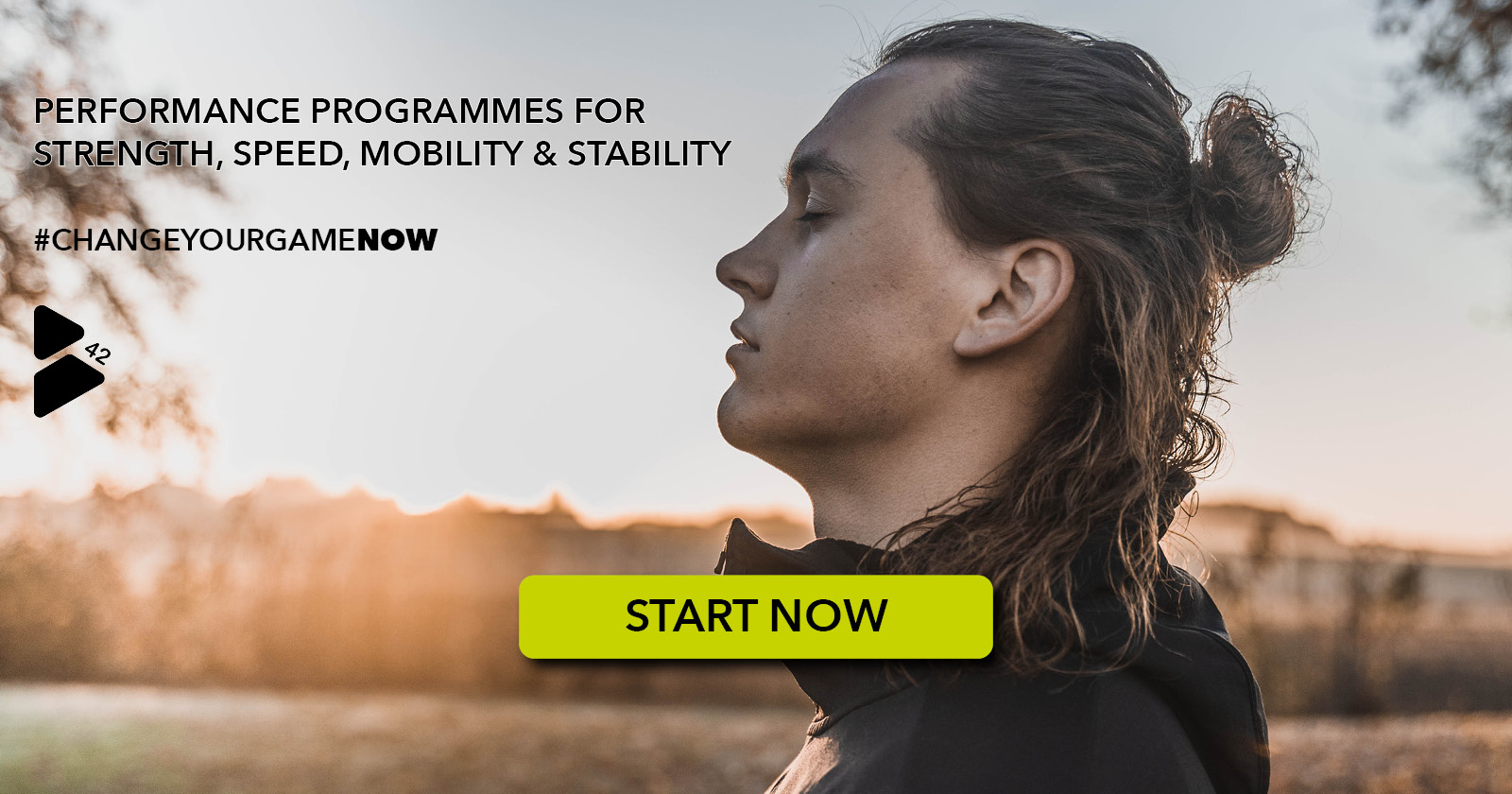A guest article about football breathing
by our expert Mirko Eckert
Around 20,000 breaths a day - given the size of the number, the relevance of breathing is immediately obvious. Or what other movement do you perform 20,000 times a day? With our breathing we supply our body and brain with oxygen.
Well over 30 muscles are involved in a deep breathing cycle. The best known respiratory muscle and primary muscle of inhalation is the diaphragm.
Besides the lung, the diaphragm is directly connected to the spinal column, the thorax, the heart and internal organs.
The associated passive movement of the organs is also one of the essential functions of breathing.
Respiratory Efficiency
Basically, breathing patterns can be more or less efficient. Respiratory illnesses, flu-like infections or injuries or restrictions of the ribs and spine can lead to long-term changes in the breathing pattern within a few days due to the large number of repetitions.
A high respiratory rate, shallow breathing and "stress breathing" are the result.
"Stress breathing" refers to the permanent use of the respiratory assistance muscles, even during low-intensity exercise. This manifests itself in the lifting and lowering of the shoulders and upper chest instead of deeper abdominal breathing.
The consequences are a permanently increased stress level of the body as well as the overstraining of the mentioned muscles, which can lead to dysfunctions and pain.
In addition, accelerated breathing leads to a reduction of the carbon dioxide (CO²) concentration in the blood, which in turn leads to an increase in the pH level. The low CO² concentration results in a constriction (narrowing) of the brain vessels, which means that the brain cannot be supplied with sufficient oxygen.
We therefore recommend that everyone integrates breathing training regularly into their training and everyday life.
Breath training - the natural booster for your brain
We can either breathe completely subconsciously or consciously.
No matter which of the countless breathing techniques and philosophies you follow, they all have one thing in common - the awareness of breathing.
A conscious breathing training leads to an activation of the entire brain and thus acts as a first-class natural booster for your training.
Our brain essentially needs two things to function: fuel (glucose & oxygen) and activation.
Did you know that your brain, although it only accounts for about 2% of your body mass, uses 20-25% of all the oxygen it takes in?
A well-perfused and fuelled brain means improved focus on your training.
Breathing exercises for football warm-up
Unless otherwise described, you should breathe in and out through your nose during all exercises, the same applies to everyday life.
Breathing through the nose promotes the production of nitric oxide (NO), which dilates the blood vessels and improves the blood flow to the skeletal muscles.
In addition, the air through the nose warms, moistens and purifies the air before it flows into the lungs.
Should you experience extreme side effects such as dizziness, chest pain, strong heartbeat, muscle spasms or numbness, please consult a doctor.
Exercise 1: Diaphragm Stretch
The activation and stretching of the diaphragm - as our primary muscle of inhalation - can directly result in improved efficiency of the breathing mechanism.
Get into a semi-kneeling position and stretch your fingertips upwards as far as possible in extension of your body's centre.
Breathe in deeply through your nose and then exhale as much as possible while holding the position.
The diaphragm is stretched during exhalation. So try to squeeze all the air out of your lungs.
Do 5-6 repetitions per side.
Exercise 2: Seated Breathing
The powerful maximum inhalation and exhalation ensures that your breathing muscles are activated and your brain is flooded with oxygen.
Breathe in through your nose at the maximum and out through your mouth at the maximum.
Feel how you actively use the muscles of the trunk to support the process of breathing.
Take 10-20 maximum breaths.
Air Hunger
The so-called Air hunger drills are not only excellent exercises to activate your brain. They also train your body's ability to cope with shortness of breath and an increase in CO² and to keep control over your breathing.
This in turn benefits your stamina. The increase in CO² also leads to vasodilatation, a widening of the blood vessels in the brain, which ensures a better supply of oxygen.
Exercises under breathlessness are characterised by the retention of air. You can hold your breath at rest or under stress, which accelerates the effects. We show you different versions
Exercise 3: Air Hunger Squat
Inhale deeply through the nose, followed by a quick and complete exhalation.
Now hold your breath and bend your knees as many times as possible until you feel a first urge to inhale again or until you start to swallow.
This is not about holding your breath for as long as possible!
Stop moving and take a deep breath, try to get back to your normal breathing rhythm as soon as possible. If you need more than 10 seconds, you have held your breath too long. In this case, reduce the number of repetitions next time. If you have recovered your normal breathing rhythm after 10-15 seconds, start the next session.
2-3 runs are enough for this exercise.
Exercise 4: Air Hunger Push-Up
Start in the push-up position and breathe in deeply through the nose. This is followed by a quick and complete exhalation.
Now hold your breath and do as many push-ups as possible until you feel an initial urge to inhale again or a swallowing stimulus sets in.
This is not about holding your breath for as long as possible!
Stop moving and take a deep breath, try to get back to your normal breathing rhythm as soon as possible.
If you need more than 10 seconds, you have held your breath too long.
In this case, reduce the number of repetitions next time.
If you have recovered your normal breathing rhythm after 10-15 seconds, start the next session.
2-3 runs are enough for this exercise.
Exercise 5: Intermittent Hypoxia
You can also integrate the shortness of breath exercises into your training and everyday life without physical exercise. No matter whether you are walking, standing, sitting or lying down. Hypoxia here refers to the reduction in oxygen availability/absorption.
First of all, breathe in and out gently via the nose.
Now hold your breath for about 15-20 seconds, you can also hold your nose.
Then, in the 10-15 second break, breathe in and out again loosely via the nose.
Use this pause optimally to control your breathing rhythm again.
6 - 8 runs
Breathing exercises for Cool Down
Furthermore, our breathing is the most effective means of deliberately influencing our autonomic nervous system - the part of the nervous system that controls our autonomous and vital functions.
With the following breathing exercises, you can actively lower your sympathetic tone, i.e. the state of stimulation of your sympathetic nervous system, thus directly initiating your regeneration.
Make sure that you do not dive into the Cool Down immediately after a high-intensity exercise. Allow your body a few minutes to cool down your cardiovascular system.
Exercise 6: Breathing Walk (5-5-5)
Walking (not jogging) at a moderate speed for a few minutes or simply a lap around the football pitch can be done together in team or individual training.
Breathe in through the nose for 5 steps, breathe out through the nose for 5 steps and then pause for 5 steps before starting the next cycle. If you experience shortness of breath during the exercise and it feels stressful, reduce the number of steps.
If you are making progress and it is getting too easy, just increase the number of steps up to 10.
Exercise 7: Cat & Cow
Mobility exercises are perfect for your Cool Down.
In particular, the mobilisation of the spine and the associated breathing in different positions complement your breathing training particularly well. In this exercise you also breathe exclusively through the nose.
Do 6-8 repetitions.
Exercise 8: Pursed Lip Breathing
The Pursed Lip Breathing is an excellent method of improving breathing skills which also promotes prolonged exhalation.
To do this, sit on a chair or lie on your back with your eyes closed, bend your legs and place your hands on your lower ribs.
Inhale deeply through the nose for 3-4 seconds, followed by twice as long (6-8 seconds) exhalation through the mouth with lips pursed. After the exhalation there is a short pause (1-2 seconds).
During inhalation, make sure that you expand your lower ribs and abdomen (forward, backward, sideways). Imagine that you are breathing into a wide lumbar protection around your waist.
This exercise is worth doing for 3-4 minutes at a time.
Integrating breathing exercises into your routines can sometimes be a real GAMECHANGER.
Improved mental focus and more efficient breathing mechanics - both at rest and under stress - can take your performance on the pitch and your recovery to a higher level.
Download the B42 football app right now:
Be Fearless.
Be Focussed.
B42
About the author
Mirko Eckert, M. Sc. Exercise Science and Coaching

Mirko von Effectus is an independent coach and speaker, neuro-athletics trainer and co-founder of "Athletiktraining Deutschland".
In addition to countless professional qualification programmes and a degree in sports science, he has several years of experience as an athletics trainer, including in football and tennis, and as a Performance Specialist at EXOS.
Instagram: effectus_ & athletiktrainingdeutschland








